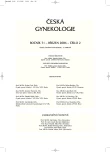New Method for Detection of Nonpalpable Breast Cancer
Nová metoda detekce nehmatných karcinomů prsu
Cíl práce:
Cílem práce byl průkaz efektivity nové metody radionavigované detekce a exstirpace nehmatného karcinomu prsu se současnou detekcí sentinelové uzliny.
Typ práce:
Prospektivní klinická studie.
Název a sídlo pracoviště:
Gynekologicko porodnická klinika 2. lékařské fakulty UK a FN Motol, Praha.
Metodika:
U 38 žen s biopticky ověřeným nehmatným karcinomem prsu bylo 18-20 hodin před chirurgickou intervencí aplikováno radiofarmakum v dávce 45 MBg do tumoru a 15 MBg subdermálně. Poté pomocí gamasondy byla provedena identifikace tumoru a jeho resekce i s okraji zdravé tkáně se současnou detekcí a vyšetřením sentinelové uzliny. Kontrolním souborem byla skupina 51 žen s nehmatnou lézí prsu označenou pomocí drátku (hook-wire).
Výsledky:
Radionavigovaná detekce okultní léze byla ve všech případech úspěšná, okraj zdravé tkáně okolo tumoru byl ve 31 případech větší než 3 mm, ve 4 případech byl 2 mm. Sentinelová uzlina byla detekována ve 100 % případů a ve 3 případech (7,9 %) byla postižena metastázou a výkon v axile byl doplněn lymfadenektomií. Ve skupině „hook-wire“ byl nalezen invazivní karcinom ve 21 případech (41,2 %), který byl exstirpován s okrajem zdravé tkáně vždy větším než 3 mm. Ztráta zdravé tkáně byla při použití hook-wire techniky o něco větší, avšak potvrzení tohoto předpokladu vyžaduje další ověření.
Závěr:
Současné provedení radionavigované exstirpace nehmatného karcinomu s biopsií sentinelové uzliny je použitelná metoda do praxe. Při srovnání s metodikou „hook-wire“ umožňuje ROLL přesnější zaměření léze a umožňuje menší ztrátu zdravé tkáně.
Klíčová slova:
karcinom prsu, nehmatné léze prsu, radionavigovaná disekce, lymfoscintigrafie, sentinelová uzlina
Authors:
P. Strnad 1; Lukáš Rob 1
; J. Chod 1; M. Halaška 1; H. Křížová 3; A. Zuntová 2; Z. Moravcová 4
Authors‘ workplace:
2. lékařská fakulta Univerzity Karlovy a Fakultní nemocnice Motol, Praha
; Gynekologicko-porodnická klinika
1; Ústav patologické anatomie
2; Klinika nukleární medicíny
3; Klinika zobrazovacích metod
4
Published in:
Ceska Gynekol 2006; 71(2): 143-145
Category:
Original Article
Overview
Objective:
The objective of the study was to evaluate the feasibility of radio guided occult lesion localization (ROLL) in the cases of nonpalpable breast cancers with sentinel lymph node biopsy.
Design:
Prospective clinical study
Setting:
Department of Gynecology and Obstetrics, 2nd Medical Faculty and Teaching Hospital, Praha
Methods:
Thirty-eight patients with nonpalpable breast cancer diagnosed by core cut biopsy underwent an injection of the radiopharmaceutical 18-20 hours before surgery. The dose of the radiopharmaceutical was 45 MBg into tumor and 15 MBg subdermaly. Surgical excision of radioactive breast tissue with nonpalpable tumor was carried out using the hand held gamma probe and the same technique was performed for biopsy of sentinel lymph node. Standard localization technique with hook-wire was performed in the control group of fifty-one patients.
Results:
Radioguided surgery of nonpalpable tumor was successful in all cases. Surgical margins were clear in all cases, in four cases (10.5%) the margins were only 2 mm. The sentinel node was identified in all cases, in 3 patients (7.9%) the sentinel node was involved by tumor and axillary lymphadenectomy was performed. Infiltrating carcinomas were diagnosed in the „hook-wire“ group in 21 cases (41.2%), all with clear margins over 3mm. Proportion of margins status between ROLL and hook-wire was the same. It seems that the health tissue loss around the tumor is in hook-wire technique bigger but it requires next study.
Conclusion:
Simultaneous performance of ROLL and sentinel node biopsy is useful and practicable methods in the management of nonpalpable breast cancer. In comparison to hook-wire, radioguided removal allows reduced excision volume and better lesion centering within the specimen.
Key words:
breast cancer, nonpalpable breast lesions, ROLL, sentinel lymph node biopsy, breast cancer surgery
Labels
Paediatric gynaecology Gynaecology and obstetrics Reproduction medicineArticle was published in
Czech Gynaecology

2006 Issue 2
Most read in this issue
- Embryo Quality Evaluation According to the Speed of the first Cleavage after Conventional IVF
- Serum Amyloid A as an Effective Marker for the Assessment of Surgical Trauma and Risk of Post-operative Complications
- Radical Parametrectomy in Women with Invasive Cervix Cancer after Previous Simple Hysterectomy
- Ursodeoxycholic Acid, S-adenosyl-L-methionine and their Combinations in the Treatment of Gestational Intrahepatic Cholestasis (ICP)
